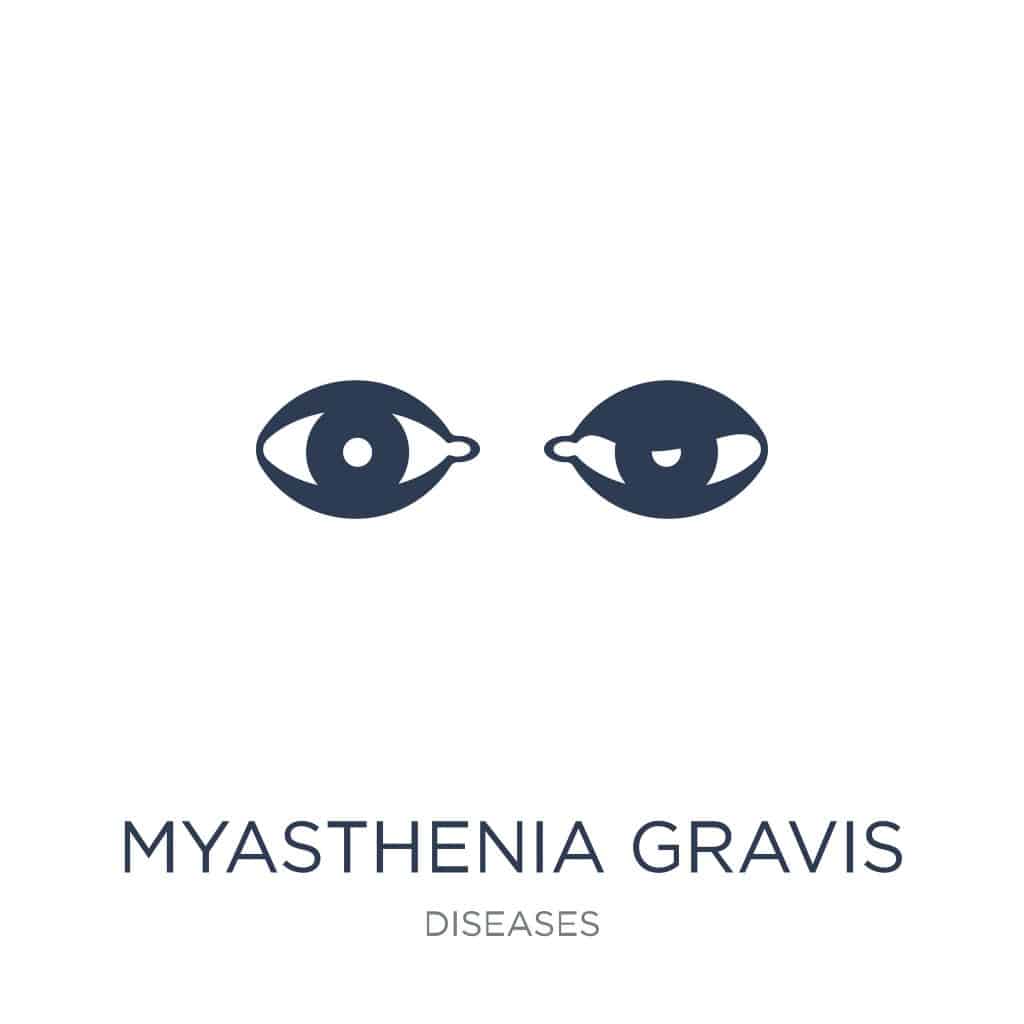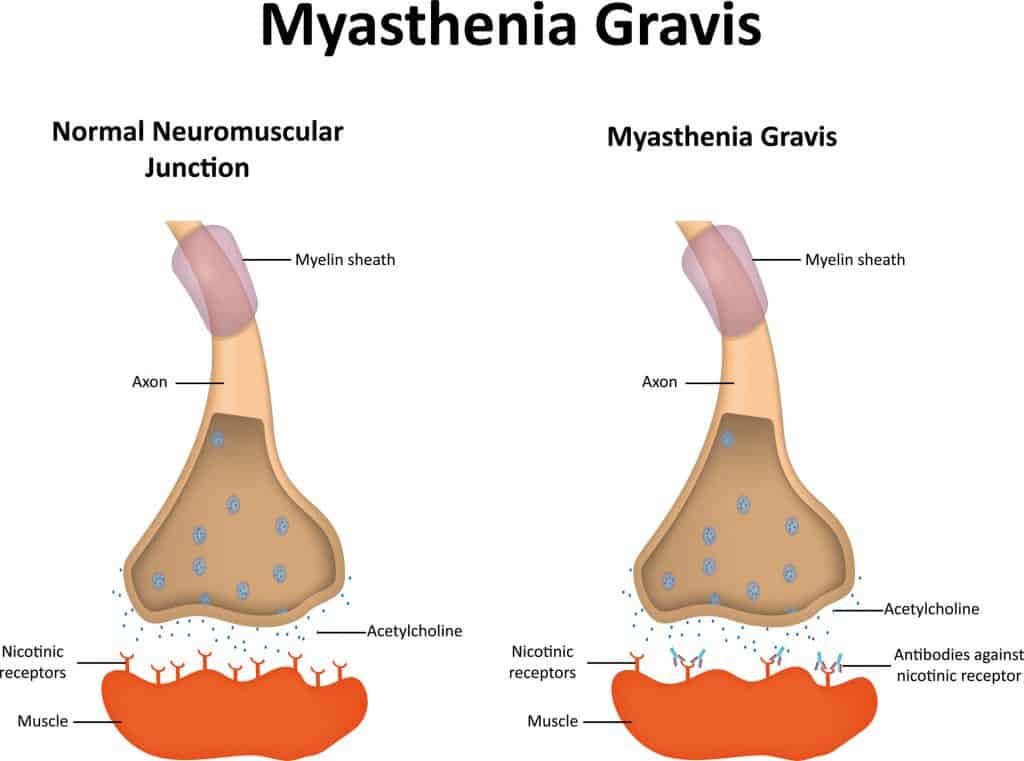What is Myasthenia Gravis? – Causes, Symptoms, Treatment
Posted by Prescription Hope - See Editorial Guidelines (Last Updated On: Thu Apr 27 2023)
Roughly 200,000 people contend with a condition known as myasthenia gravis. But what exactly is myasthenia gravis, and who does it affect?
In this article, we will cover what this condition is, who it affects, what causes it, and the symptoms to look for. Here is a quick summary to give you a basic understanding before we get into the details.
What is Myasthenia Gravis? Myasthenia gravis is a fairly rare condition that is characterized by a lack of communication between nerves and muscles that causes rapid fatigue and weakness. Anyone can be affected by this condition; however, women under 40 and men over 60 are most likely to be affected. There is currently no cure for myasthenia gravis, but it can be treated.
Now, lets gain a better understanding of what myasthenia gravis is.
What is Myasthenia Gravis?

Myasthenia gravis is a rare neuromuscular disorder that consists of rapid fatigue and weakness of muscles. The name, which literally means grave muscular weakness, was given to the condition in the 1880s. Roughly 14 out of every 100,000 people are affected by this condition.
During this condition, communication between nerves and muscles is disrupted. Nerve to muscle communication is often referred to as neuromuscular junction. The disruption at the neuromuscular junction prevents muscles from contracting, leading to muscle weakness.
Myasthenia gravis is an autoimmune condition, meaning the body’s immune system attacks itself. There are two forms of this condition, which are generalized and ocular.
In ocular myasthenia gravis, the eyelids and muscles that control the eye are affected and become weak. In generalized myasthenia gravis, individuals may experience ocular muscle weakness along with muscle weakness of the extremities or respiratory muscles.
Symptoms of Myasthenia Gravis
Myasthenia gravis weakens the voluntary muscles (the muscles we control at will) of the body. So, involuntary muscles, such as the heart and gastrointestinal tract, are not impacted.
This condition most often affects the ocular muscles, making it difficult to control the movement of the eyes. So, some of the first symptoms of myasthenia gravis include eye paralysis, double vision, and droopy eyelids.
Early symptoms may consist of weakness of the jaw and neck. Fatigue of the muscles around the neck and jaw can make it difficult to talk, chew, and swallow.
The symptoms of muscle weakness tend to spread from the eyes to the face, neck, arms, hands, and then to lower extremities. Individuals may find it difficult to raise arms, grip heavy objects, standing up after sitting down, and walking longer distances.
Typically, the symptoms of myasthenia gravis start to improve with rest. The more you use the muscle that is being affected, the worse the symptoms will become.
What Causes Myasthenia Gravis

Myasthenia gravis is an autoimmune disorder. So, the immune, which is responsible for protecting the body against infection, erroneously attacks the body.
When the immune system attacks itself under this condition, there is a fault in the transmission of impulses from the nerves to the muscles. The normal process for muscle contraction goes as follows.
Electrical impulses move down motor nerves. The nerve endings will then be triggered to release acetylcholine, which is a neurotransmitter. Acetylcholine then binds to receptors on the muscle, which then causes a contraction.
When a person has myasthenia gravis, though, antibodies either block or destroy the acetylcholine receptors. The antibodies are immune proteins produced by one’s immune system.
The thymus gland may be associated with the onset of myasthenia gravis as well. The thymus gland plays a crucial part in the development of the immune system. It usually increases in size up until puberty before it gets smaller and is replaced by fat
However, those with myasthenia gravis may have a larger than normal thymus gland and develop tumors on the gland (thymomas). The gland may then provide incorrect instructions for the development of immune cells, causing the immune system to attack itself mistakenly.
Who is Affected?
Anyone can be affected by myasthenia gravis. However, those that are mostly affected include women under the age of 40 and men over 60. As far as we know, this condition is not hereditary, and it is not contagious.
If a pregnant woman has myasthenia gravis, then there is a chance that she may pass the antibodies on to her baby. This is called neonatal myasthenia. This is usually temporary, and the child only has symptoms for a few months after birth.
Diagnosing Myasthenia Gravis
A doctor may perform various tests and examinations to confirm whether or not one has myasthenia gravis. Here are potential tests your doctor may perform to diagnose this condition:
- Physical Examination: During a physical examination, the doctor will first look at the patient’s medical history and examine their physical condition. This includes checking their muscle strength, muscle tone, coordination, sense of touch, and functioning of their eye movements.
- Tensilon Test: This test includes an injection of Tensilon (edrophonium). Your muscle strength is then evaluated to determine if your weakness is caused by myasthenia gravis.
- Blood Test: A blood test may be performed to determine one’s levels of acetylcholine receptor antibodies, as those with this condition are likely to have higher levels of these antibodies.
- Repetitive Nerve Stimulation: A nerve stimulation test consists of stimulating nerves with electrical impulses, causing muscles to contract. When someone has a neuromuscular disorder, such as myasthenia gravis, their muscle fibers may not respond to electrical impulses.
- Diagnostic Imaging: Your doctor may order you to have an MRI or some other imaging done of your chest to check for problems with your thymus gland.
Treatment Options
Myasthenia gravis cannot be cured currently, but there are treatment options available to help control the condition.
Thymectomy is one potential treatment option, which is the removal of the thymus gland. Removing the thymus gland has been shown to help improve muscle weakness and balance out the immune system. A thymectomy is more so recommended to those with thymomas under 60 years old with moderate to severe weakness from myasthenia gravis.
Monoclonal antibodies consist of a treatment that triggers the immune system to target the process of acetylcholine antibodies injuring the receptors. Soliris is a medication approved by the FDA that is a monoclonal antibody that can be used to treat myasthenia gravis.
Anticholinesterase medications, such as Mestinon, prevent the destruction of acetylcholine, which improves the communication between nerves and muscles. Therefore, individuals increase muscle strength.
Immunosuppressive medications, such as Prograf or Imuran, can treat this condition by suppressing the body’s immune system. By decreasing the activity of the immune system, the fewer antibodies there are that cause the disrupted communication between nerves and muscles. It is important to mention here that immunosuppressive drugs can have serious side effects.
With treatment, individuals contending with this condition can live close to normal lives. Some patients may have their condition go into remission, allowing for normal muscle growth and strength.
Conclusion
We hope this has given you a better understanding of what myasthenia gravis is and what your treatment options are. Always consult your doctor with questions regarding your specific condition and treatment.
If you are having trouble affording the medication you need to treat your condition, then Prescription Hope may be able to help. We work directly with pharmaceutical companies to provide you with the prescription drugs you need for just $60.00 a month through Prescription Hope’s medication access service for each medication. Enroll with us and start saving money.

